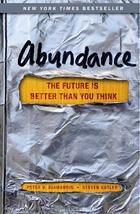A Review of "Abundance" by Diamandis & Kotler
 This book was an enjoyable read. The authors’ choice of topics, use of data, and integration of analyses of both biological and cultural evolutionary principles were extremely valuable and kept me intrigued with visions of what all these futuristic advancements may look like. For a book with 239 pages of chapter content, the additional 115 pages of references and follow-up information make this book not only enjoyable, but also a valuable resource.
This book was an enjoyable read. The authors’ choice of topics, use of data, and integration of analyses of both biological and cultural evolutionary principles were extremely valuable and kept me intrigued with visions of what all these futuristic advancements may look like. For a book with 239 pages of chapter content, the additional 115 pages of references and follow-up information make this book not only enjoyable, but also a valuable resource.
Abundance offers an important point concerning how human habits still need to change if technological change is to effectively impact global growth and sustainability. Given the widespread interest in areas such as healthy habits, green initiatives, and culture I would highly recommend this book, with an added emphasis for a potential reader to also integrate readings and training in behavioral principles. The authors refer to the passion of individuals and other motivators as essential features of change; however the key here is the analysis and management of behavior, which is integral for the performance commitment referred to in the book. Knowledge of behavior analysis combined with the information provided in the book offers a unique picture of sustainability and maintenance of changing habits.
As a subject central to all facets of society, Abundance is well-written to address the topic of societal wellbeing and sustainability. Diamandis and Kotler review areas of past, current, and future advancements spanning from robotics to medicine to energy and do so with substantial resources and supporting data. They use examples and verbiage that speak to a wide audience and offer an exciting look into future advancements, both in the distant future and, as is the target of the book, in the next two or three decades.
Part 1 of the book starts by offering examples and lessons that broaden such topics as population control, the notion of scarcity in resources, and the advancement and accessibility of technology across all strata of society. The authors then consider their “Pyramid of Abundance”, with reference to Maslow’s theory involving a “Hierarchy of Human Needs.” Chapter 4 anchors Part 1 with a perspective on cumulative progress and lessons of optimism to show that we can help control our quality of life.
In Part 2, the discussion moves toward the concept of exponential technologies, spanning historical and modern examples to discuss prediction and technological rate of change. Chapter 6 then offers a review of some of the most exciting recent breakthroughs in technology, including such areas for future impact as artificial intelligence, robotics, medicine, and nanotechnology, offering an interesting glimpse into the future of these technologies, including the use of algae as an ultra-low-cost fuel.
Part 3 of Abundance addresses the simple physiological needs that are the base of the aforementioned pyramid and note the generality of the chain of effects cycling from technology to such diverse areas as biological evolution and modern cultural evolution. Chapters 7 through 9 provide examples supporting this cycle and the base of the pyramid while also offering an analysis of the use, sustainability, and profitability of food and water.
Part 4 begins with a description of various Do-It-Yourself innovators, which are offered as examples of what the authors refer to as the most potent force of abundance. Chapter 11 moves to the technophilanthropists, showing a range of examples of how and where individuals donate money and how these efforts can benefit society. Chapter 12 completes Part 4 by describing the rising “bottom billion” of the lowest economic strata and the advantages new technologies have toward “dematerialization”.
Part 5 begins by reviewing cases of energy poverty and innovation, including not only areas of energy resources but also energy distribution. Chapter 14 transitions to education, the use of computers, and what has influenced the content used in our education systems since the industrial revolution. Healthy living and health care are discussed in Chapter 15, with Part 5 concluding with the various categories and interpretations of freedom.
As the final main section of the book, Part 6 gets to an all-too-familiar point: Just because we have the information and tools for a sustainable future, can we get there? Chapter 17 provides four major motivators that drive innovation, with Chapter 18 discussing the role of risk taking and failure. This last part of the book concludes with Chapter 19 reviewing the notion of abundance as both a plan and a perspective and that our perspective shapes our reality.
Diamandis, P. H., & Kotler, S. (2012). Abundance: The future is better than you think. New York: Free Press.
Reviewed by:
Nic Weatherly, Ph.D.


